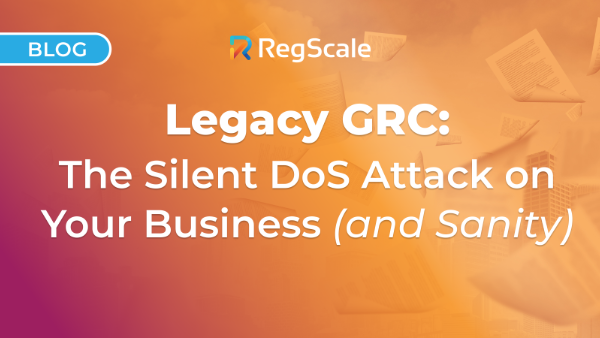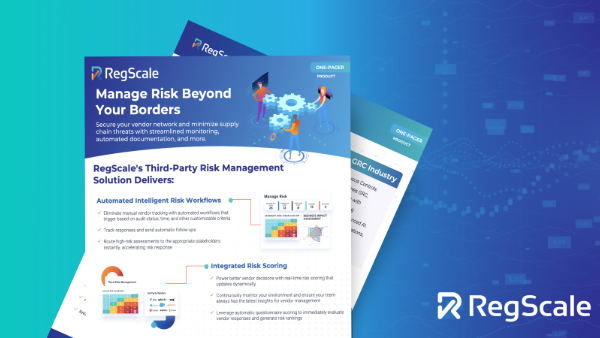Legacy GRC: The Silent DoS Attack on Your Business (and Sanity)

Let’s be honest, folks. When we hear “Denial of Service (DoS) attack,” we picture shadowy figures in hoodies, furiously typing code to bring down a website. We think of flashing red lights, panicked IT teams, and maybe a few dramatic news headlines. But what if I told you there’s a far more insidious, albeit less visually exciting, DoS attack happening within the very walls of your organization? I’m talking about Legacy Governance, Risk, and Compliance (GRC).
Yes, you heard me right. That sprawling spreadsheet monster, that labyrinthine policy document, those manual processes that take longer to complete than building the great pyramids of Egypt – they’re not just annoying; they’re actively choking the life out of your business, one painstakingly slow step at a time.
Think about it from the business perspective in your organization. You’ve got this shiny new, game-changing technology that promises to revolutionize your organization. The business/mission teams are salivating, the engineers are buzzing, and your competitors are probably quaking in their boots. But then… cyber security and the legacy GRC team get involved.
Suddenly, the brakes slam on harder than the Dallas Cowboys offense in the playoffs. What follows is a bureaucratic nightmare of epic proportions:
- The Manual Paperwork: Policies are dusted off like ancient scrolls, and their relevance to the new tech is debated with the intensity of a
- The Checkbox Risk Process: Risk assessments are conducted using lengthy questionnaires designed during the Y2K scare. These questionnaires ask about threats that haven’t existed in decades and ignore the real risks to the enterprise.
- The Bureaucratic Relay Race: Approval workflows meander through departments like a lost tourist in a corn maze, requiring signatures from people who don’t understand the technology and probably think “cloud” is something that makes rain.
Weeks turn into months. The innovative technology gathers digital dust. Your competitors, unburdened by the GRC equivalent of a three-legged race, zoom ahead. Sound familiar? That, my friends, is the silent scream of a business being DoS’d by its own well-intentioned, yet tragically outdated, GRC practices.
Leveraging legacy GRC for new technology is like trying to race a Formula 1 car with your head safety inspector, who must complete their 1000-point safety inspection before they allow you to drive the car. By the time the paperwork is done, the race is over, and you will be lucky if they let you get a participation trophy.
The Onboarding Black Hole
Nowhere is this Legacy GRC DoS attack more potent than in government and highly regulated industries. Introducing new technologies feels less like innovation and more like navigating a minefield blindfolded. The fear of non-compliance, coupled with the snail-speed of manual processes, creates a natural risk aversion to anything that isn’t business as usual.
The result? Innovation stagnates. Businesses become reactive, forever chasing their tails trying to patch vulnerabilities and address audit findings after they happen. It’s like waiting for your house to catch fire before you even think about buying a smoke detector. It doesn’t make any sense, but the industry has done this for decades in GRC, where it is business as usual unless they get a bad audit or a cyber breach.
The Antidote: Continuous Controls Monitoring (CCM) – Fixing the Corroded Gears of Legacy GRC
The good news is that we don’t have to live in this GRC-induced state of operational paralysis. The solution isn’t to throw out GRC altogether; after all, regulations exist for a reason, and you can’t just ignore them. It’s about evolving from manual, reactive dinosaurs to proactive, continuous monitoring ninjas.
Imagine a world where risk and compliance aren’t afterthoughts but baked into your processes from the start. A place where technology onboarding isn’t a multi-month Greek odyssey, but a streamlined, efficient process driven by real-time data. This isn’t some futuristic fantasy; it’s the promise of modern GRC solutions powered by CCM.
That is why we built RegScale, the award-winning CCM platform. RegScale isn’t a legacy GRC software. It is a supercharged continuous controls monitoring platform powered by compliance as code and artificial intelligence (AI). We’re talking about a platform built for the speed and complexity of today’s digital landscape. RegScale empowers you to:
- Automate the Manual Mayhem: Say goodbye to endless spreadsheets and hello to automated workflows that keep pace with your business.
- Embrace Proactive Insights: Continuous monitoring provides real-time visibility into your risk and compliance posture, allowing you to address issues before they become fire drills, failed audits, or breaches.
- Onboard with Agility: Integrate new technologies faster and with greater confidence, knowing that risk and compliance are built-in, not bolted-on.
- Speak the Language of Innovation: RegScale helps bridge the gap between security, risk, and compliance teams, fostering collaboration and understanding.
Stop letting legacy GRC be the silent DoS attack crippling your business. It’s time to ditch the manual madness, embrace proactive continuous monitoring, and unlock the true innovation potential of your organization. It’s time to get RegScale. Your sanity (and your bottom line) will thank you. Schedule a demo with us today.
Ready to get started?
Choose the path that is right for you!
Skip the line
My organization doesn’t have GRC tools yet and I am ready to start automating my compliance with continuous monitoring pipelines now.
Supercharge
My organization already has legacy compliance software, but I want to automate many of the manual processes that feed it.
